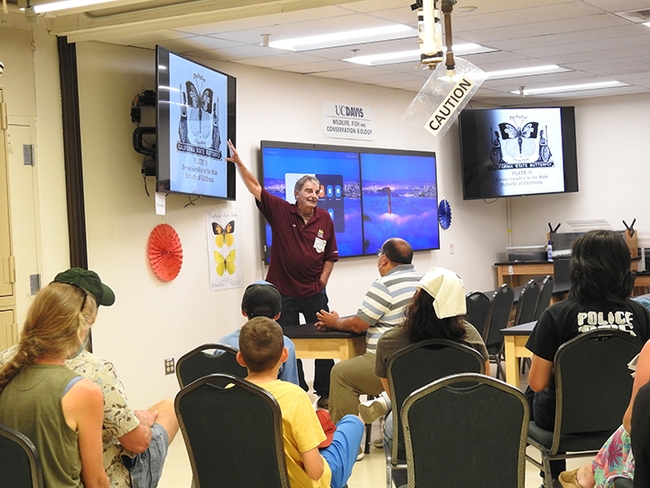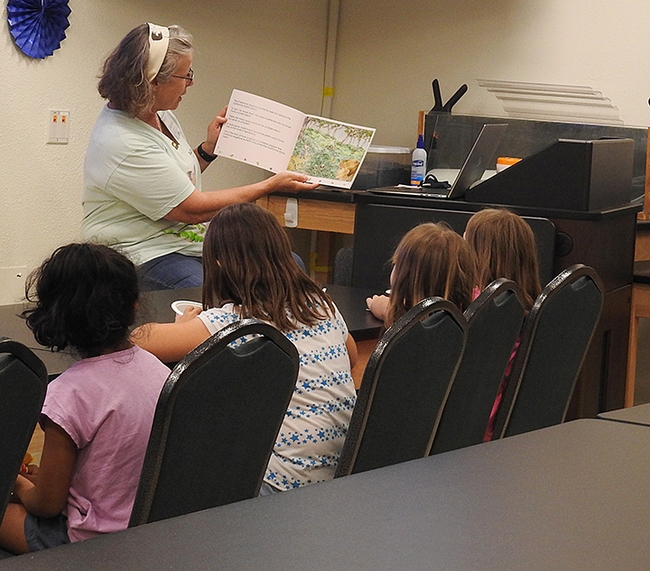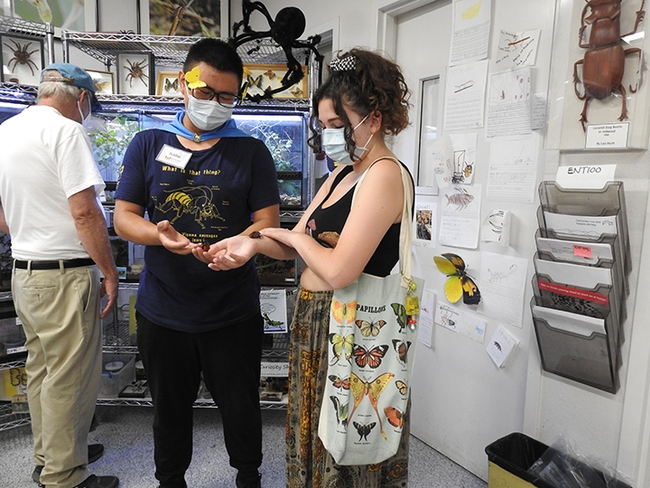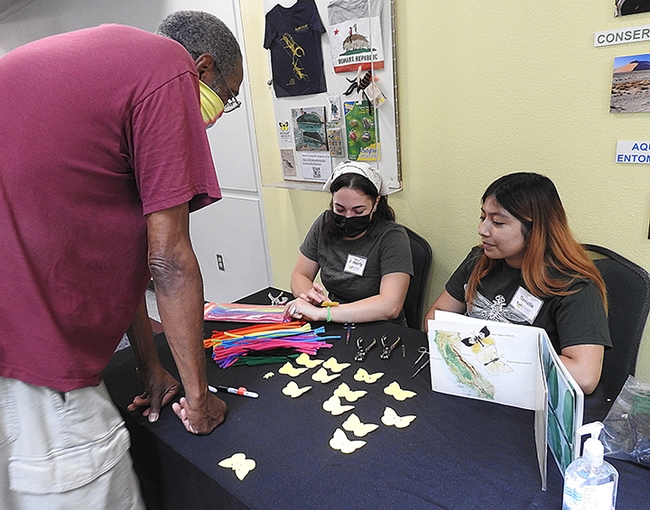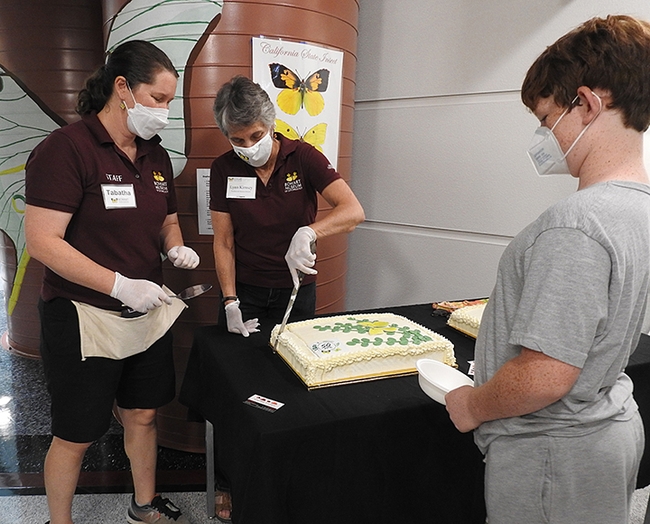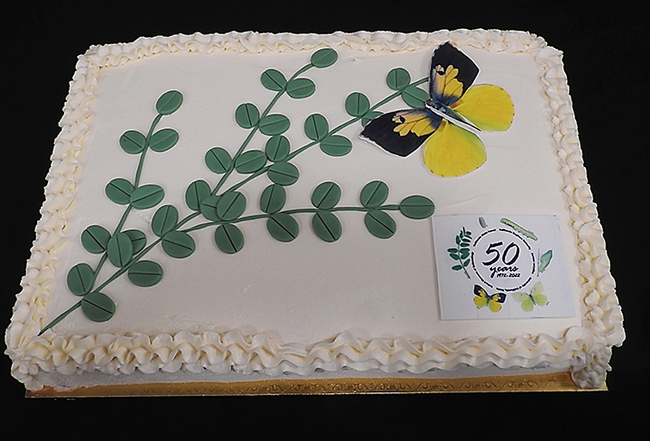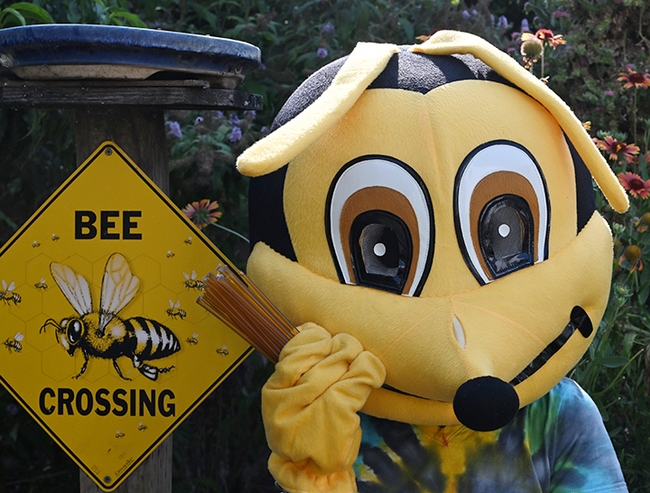- Author: Kathy Keatley Garvey
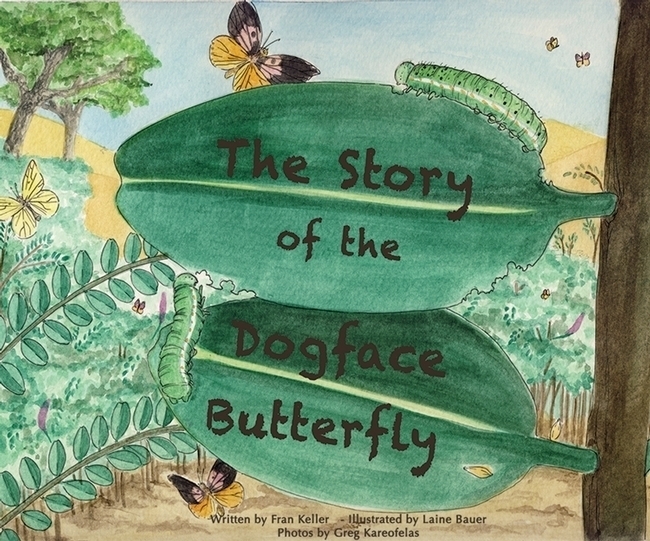
And it's double delightful with twins!
Such was the case at the Vacaville Museum Guild's recent Children's Party when two-year-old twins Ford and Wyatt Devine were thumbing through "The Story of the Dogface Butterfly," a children's book written by UC Davis doctoral alumna Fran Keller, a Folsom Lake College professor and a Bohart Museum of Entomology research scientist.
The twins, along with big brother, Buck, 7, were among the youngsters fascinated by the book, which features macro images by Bohart associate Greg Kareofelas and illustrations by Laine Bauer, then a UC Davis student.
It was just one of the many attractions at the annual Children's Party, held Aug. 8 in the museum courtyard.
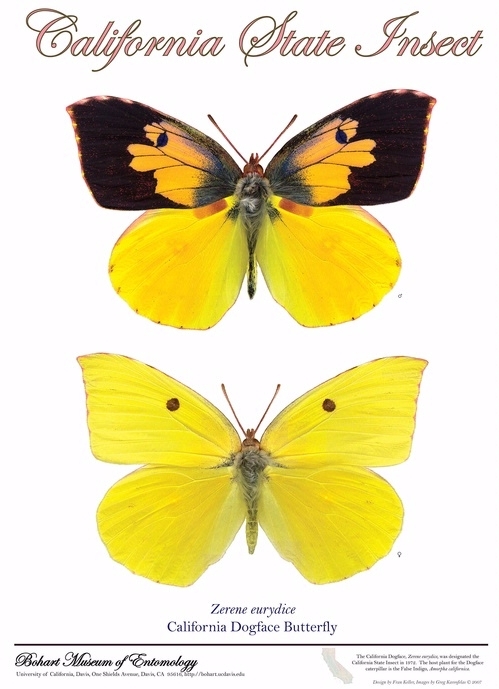
Not many know that the butterfly's most prevalent habitat is the 40-acre Shutamul Bear River Preserve near Auburn, on a Placer Land Trust conservation site; Kareofelas serves as a docent on the Placer Land Trust tours. (See virtual tour on YouTube). The butterfly is there because its larval host plant, false indigo (Amorpha californica), is there.
Are there dogface butterflies in Vacaville? Yes. The butterfly's breeding grounds include Gates Canyon. (See UC Davis emeritus professor Art Shapiro's website.)

Director of the insect museum is Professor Jason Bond, the Evert and Marion Schlinger Endowed Chair, UC Davis Department of Entomology and Nematology, and associate dean, Agricultural Sciences, UC Davis College of Agricultural and Environmental Sciences.
Meanwhile, Bohart scientists are gearing up for their next open house, set for 1 to 4 p.m., Saturday, Sept. 28. The theme is "Museum ABC's: Arthropods, Bohart and Collecting." All open houses are free and family friendly. Parking is also free. For more information, contact bmuseum@ucdavis.edu or access the website at https://bohart.ucdavis.edu.
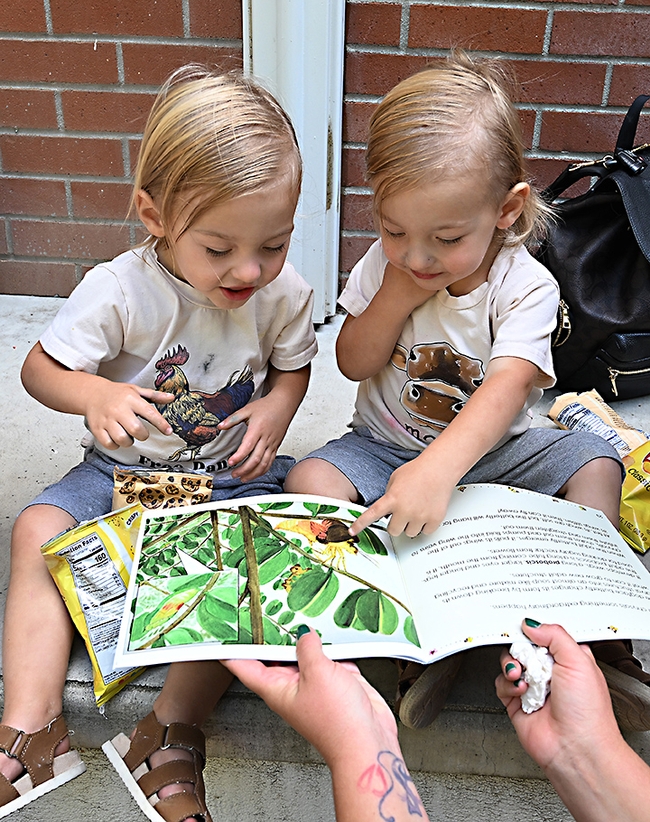
- Author: Kathy Keatley Garvey
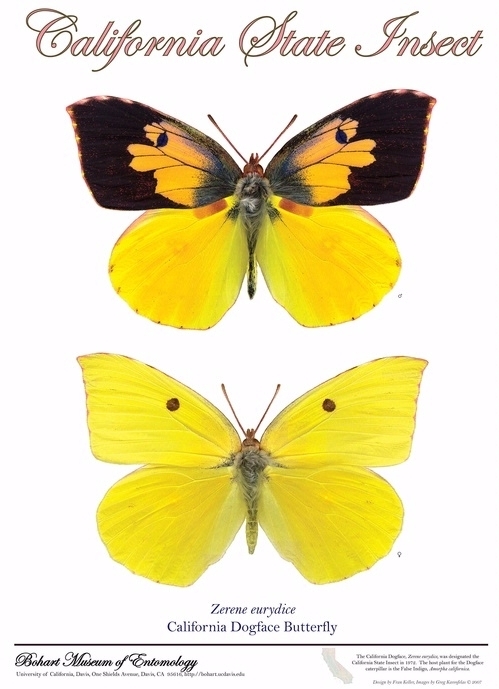
Did you know that California has a state insect? It does.
Is it the honey bee? No.
Is it the lady beetle (ladybug)? No.
Bumble bee? No.
It's the California dogface butterfly (Zerene eurydice), an insect found only in California.
The state Legislature designated it as the state insect in 1972. The butterfly is nicknamed "dogface" in reference to the silhouette of what resembles a poodle head on the wings of the male. The female is mostly solid yellow except for a single black spot on its upper wings.
Most people have never seen it in the wild. But if you've visited the Bohart Museum of Entomology at UC Davis, home of a global collection of 8 million insect specimens, you know that its logo is the California dogface butterfly.
And on Thursday, Aug. 8 those attending the Vacaville Museum Guild's Annual Children's Party (sold out) will see specimens from the Bohart Museum, as well as macro images of the butterfly, the work of talented Bohart associate Greg Kareofelas of Davis.
Tabatha Yang, education and outreach coordinator of the Bohart, has donated a drawer of the specimens for visitors to see. They can also pose in a cutout of the Bohart Museum's California dogface butterfly banner. And thumb through a 35-page children's book, "The Story of the Dogface Butterfly," written by UC Davis doctoral alumna Fran Keller, a professor at Folsom Lake College and a Bohart Museum research scientist. The book includes images by Kareofelas and Keller. Laine Bauer, then a UC Davis student, contributed the illustrations.
The book, published in 2013, tells the untold story of the California dogface butterfly, and how schoolchildren became involved in convincing the State Legislature to select the colorful butterfly as the state insect. Fourth grade students of Betty Harding and Shirley Klein, Dailey Elementary School, Fresno, advocated it as the state insect. The teachers and students enlisted the help of State Assemblyman Kenneth L. Maddy, who authored AB 1834. On July 28, 1972, Governor Ronald Reagan signed the bill into law, designating the California dogface butterfly the official "State Insect of California." (Read more on how the butterfly became the state insect under the Ronald Reagan administration.)
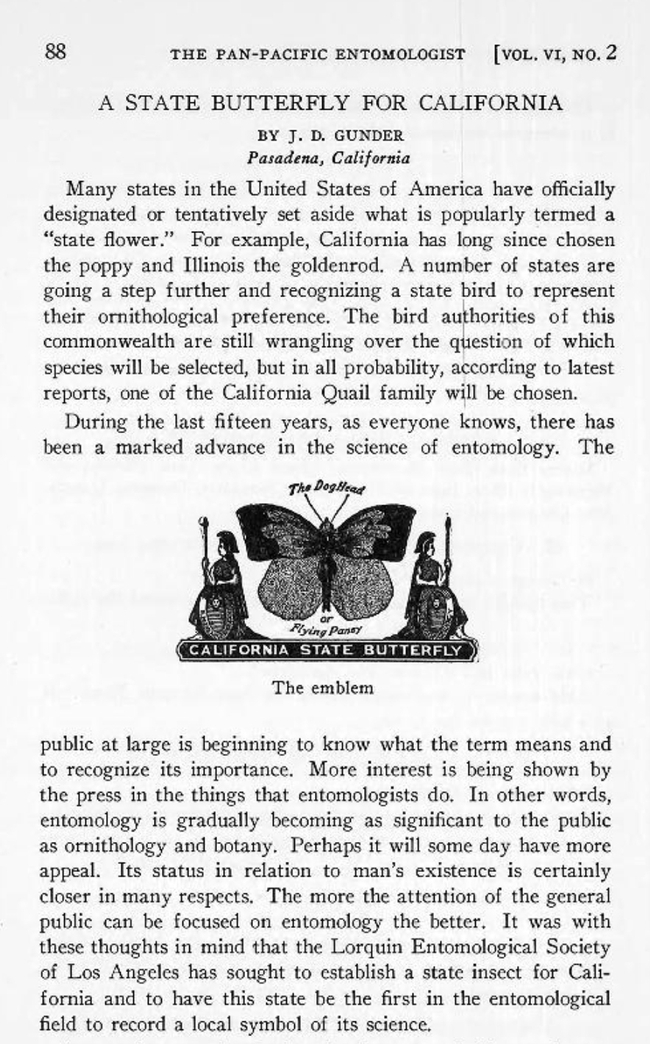
The most prevalent habitat of the California dogface butterfly is the 40-acre Shutamul Bear River Preserve near Auburn, on a Placer Land Trust conservation site; Kareofelas serves as a docent on the Placer Land Trust tours. (See virtual tour on YouTube). The butterfly is there because its larval host plant, false indigo (Amorpha californica), is there.
Are there dogface butterflies in Vacaville? Yes. The butterfly's breeding grounds include Gates Canyon. (See UC Davis emeritus professor Art Shapiro's website.)
As mentioned, few people see the butterfly in the wild. However, its image graces a first-class U.S. stamp and California driver licenses. It's also depicted on the California State Fair monorail.
Butterfly Poster and Book. The Vacaville Museum Guild's Children's Party (see what's on tap) also will spotlight a Bohart Museum poster by Kareofelas-Keller that depicts the male and female butterfly. (Both the poster and the book are available for sale in the Bohart gift shop; net proceeds benefit the insect museum's education, outreach and research programs.)
The Bohart Museum, located in Room 1124 of the Academic Surge Building, 455 Crocker Lane, also houses a petting zoo (featuring stick insects, Madagascar hissing cockroaches and tarantulas) and a insect-themed gift shop, stocked with books, posters, t-shirts, hoodies, jewelry and collecting equipment. Director of the insect museum is Professor Jason Bond, the Evert and Marion Schlinger Endowed Chair, UC Davis Department of Entomology and Nematology, and associate dean, Agricultural Sciences, UC Davis College of Agricultural and Environmental Sciences.
The Bohart is open for walk-in visitors on Tuesdays from 9 a.m. to noon and from 1 to 4:30 p.m. through Aug. 27. It will be closed to the public Sept. 1-22.
The next open house is set for 1 to 4 p.m., Saturday, Sept. 28. The theme is "Museum ABC's: Arthropods, Bohart and Collecting." All open houses are free and family friendly. Parking is also free. For more information, contact bmuseum@ucdavis.edu or access the website at https://bohart.ucdavis.edu.
Links:
- Golden Year for the California Dogface Butterfly (Bug Squad post, Feb. 4, 2022)
- Rob on the Road, KVIE, Public Broadcasting Service (PBS) (First aired July 7, 2017)
- Capital Public Radio Piece on Dogface Butterfly (featuring Greg Kareofelas)
- Pacific Land Trust website (PLT maintains a conservation site in Auburn that's the home of the California dogface butterfly)
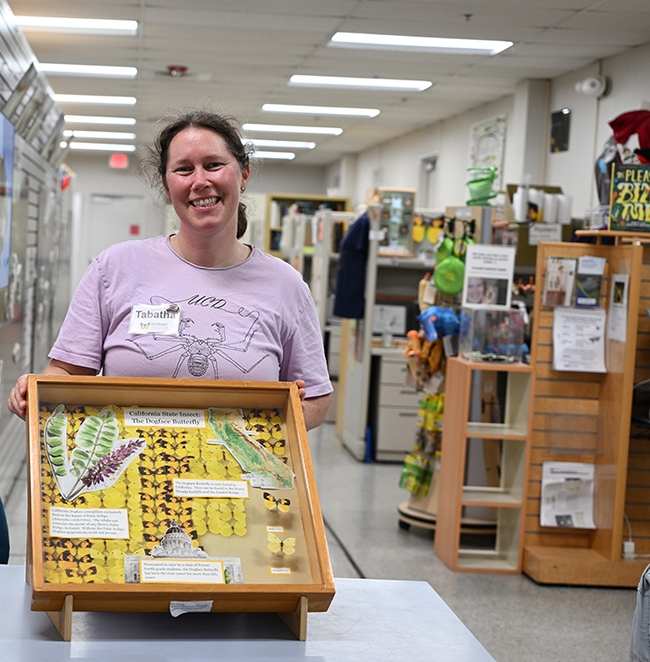
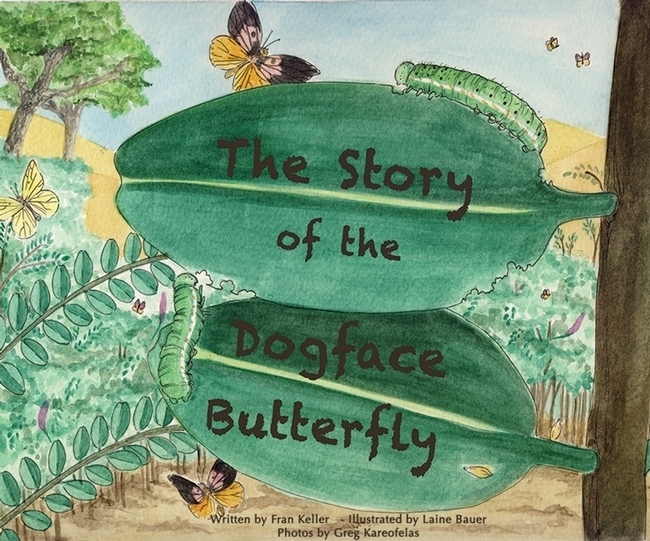
- Author: Kathy Keatley Garvey
The Vacaville Museum Guild's annual children's party--for Vacaville children ages 3 to 9--promises to be a honey of a party.
Themed "Fun on the Farm," it's an entertaining and educational event set for 10 a.m. to 12:30 p.m., Thursday, Aug. 8 in the museum courtyard, 213 Buck Ave.,Vacaville.
Coordinators Pamela King and Diana McLaughlin said the children's party will include a walk-around Queen Bee handing out honey sticks, and a real "Queen Bee"--Ettamarie Peterson of Petaluma, known as the Queen Bee of Sonoma, who will display a bee observation hive. Another Queen Bee, Amina Harris, has donated honey sticks.
The event also will include animals from the Vaca Valley Grange (including goats, chickens, rabbits and a donkey), a costumed Mother Goose reading children's stories, face-painting by the Vacaville Rainbow Girls, and a ring toss with a hobby horse named Trigger (the work of Perry Shull and Georganne Gebers). The youngsters will create sand art jars, craft paper crowns, plant seeds in a take-home container, and pose for photos behind a UC Davis Bohart Museum of Entomology California dogface butterfly cut-out banner. The School of Rock will entertain. Vacaville police officers, Solano County Sheriff deputies, and the California Highway Patrol will "meet and greet" and offer replica badges and other memorabilia.
The menu, free with the $3 admission, includes hot dogs, popcorn, chips, cookies and water. Tickets can be purchased only at the museum on Thursdays through Saturdays between 1 p.m. and 4:30 p.m.
Capsule information:
Ettamarie Peterson. She's a retired teacher, a longtime beekeeper, a 4-H beekeeping leader and a great-grandmother who loves to talk about bees and show her bee observation hive at schools and special events. She'll point out the queen bee, worker bees and drones and discuss their roles. “I started beekeeping before I retired in 1998 from 37 years of teaching,” Peterson says. She has served as president and treasurer of the Sonoma County Beekeepers' Association (SCBA) and edits the SCBA newsletter, The Monthly Extractor. She collects swarms for her Liberty 4-H Club beekeepers. "I got involved in 4-H when my son wanted his daughters to learn how to keep bees. They are both parents now so I am hoping to teach the three great-grandsons, too!"
Peterson is also a longtime friend and supporter of UC Davis. She delivered a tribute to the late Eric Mussen (1946-2022), a 38-year California Cooperative Extension apiculturist and member of the Department of Entomology and Nematology faculty.
Queen Bee Costume. The queen bee costume is from the UC Davis-based California Master Beekeeper Program (CAMBP), founded and directed by apiculturist/bee scientist Elina Lastro Niño, associate professor of UC Cooperative Extension, and a member of the faculty of the Department of Entomology and Nematology. CAMBP is "a continuous train-the-trainer effort," the website explains. "The CAMBP's vision is to certify Honey Bee Ambassador, Apprentice, Journey, and Master level beekeepers so they can effectively communicate the importance of honey bees and other pollinators within their communities, serve as mentors for other beekeepers, and become the informational conduit between the beekeeping communities throughout the state and UCCE (UC Cooperative Extension) staff." Program managers are Wendy Mather and Kian Nikzad.
Honey Sticks. The wildflower honey sticks were donated by Amina Harris, founding director of the UC Davis Honey and Pollination Center who retired last year to return to her family business, Z Food Specialty and The HIVE, 1221 Harter Ave, Woodland. The Hive is known as the largest honey and mead tasting room in California and is newly featured in Travel and Leisure. A community gathering place, The Hive "aims to educate and engage visitors in varietal honeys, mead, honey bees, and pollinators." A honey-inspired menu features local and seasonal farm-to-fork foods. A pollinator garden and musical presentations are also draws. Amina's husband, Ishai Zeldner (he passed in 2018 at age 71), founded the business. Amina serves as the Queen Bee; son, Josh Zeldner is the nectar director, and daughter, Shoshana Zeldner, is the director of brand strategy. See more about the family and its business here.
Be a Butterfly. Attendees will pose for pictures behind the cut-out California dogface butterfly banner from the Bohart Museum. They also will see Bohart associate Greg Kareofelas' macro images of the egg, caterpillar, chrysalis and adult. The California dogface butterfly, Zerene eurydice, is the state insect, as designated by State Legislature in 1972. The butterfly is found only in California from the foothills of the Sierra Nevada to the Coast Ranges and from Sonoma south to San Diego. Its habitat also includes Gates Canyon, Vacaville. The male butterfly, which sports a yellow silhouette of a dog's head on its wings, is known as "the flying pansy." The female is mostly solid yellow except for a single black spot on its upper wings.
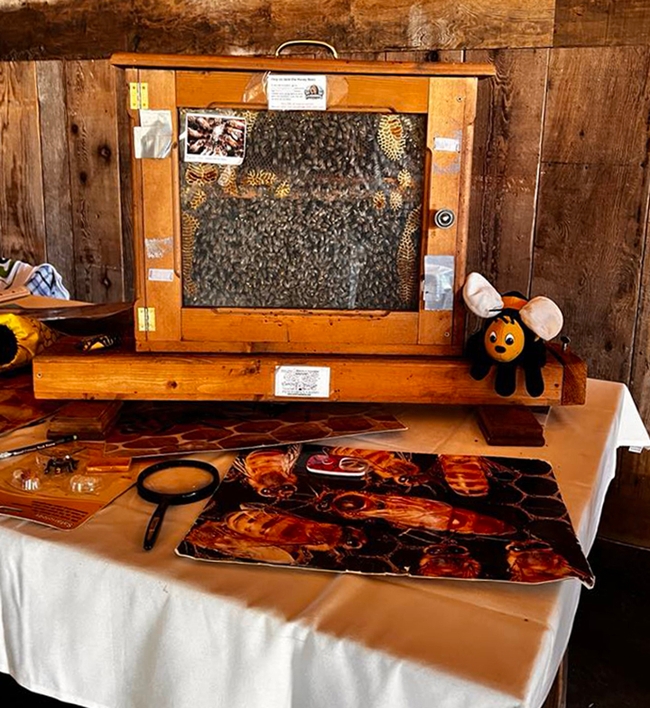
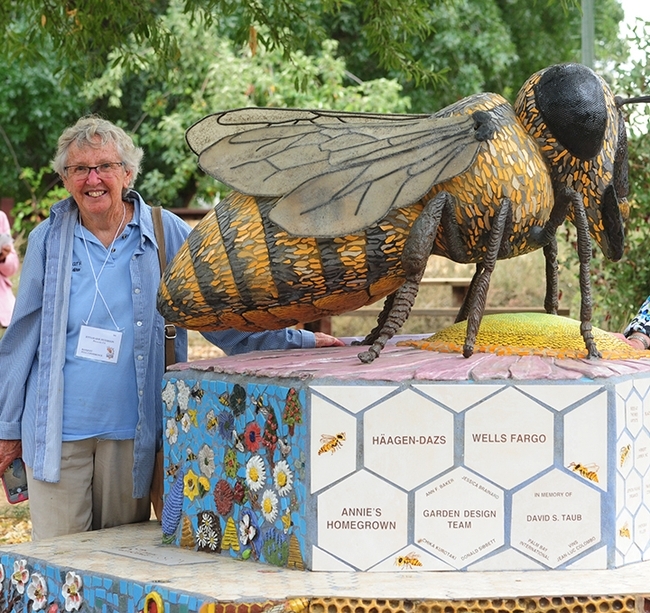
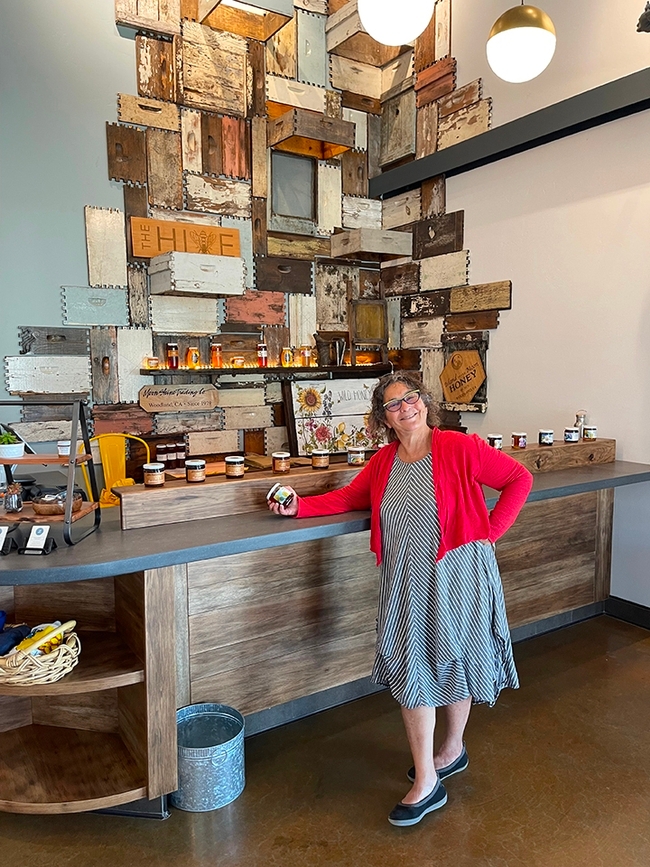
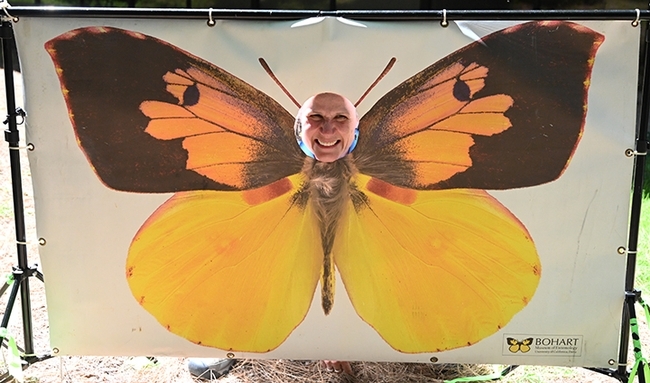
- Author: Kathy Keatley Garvey
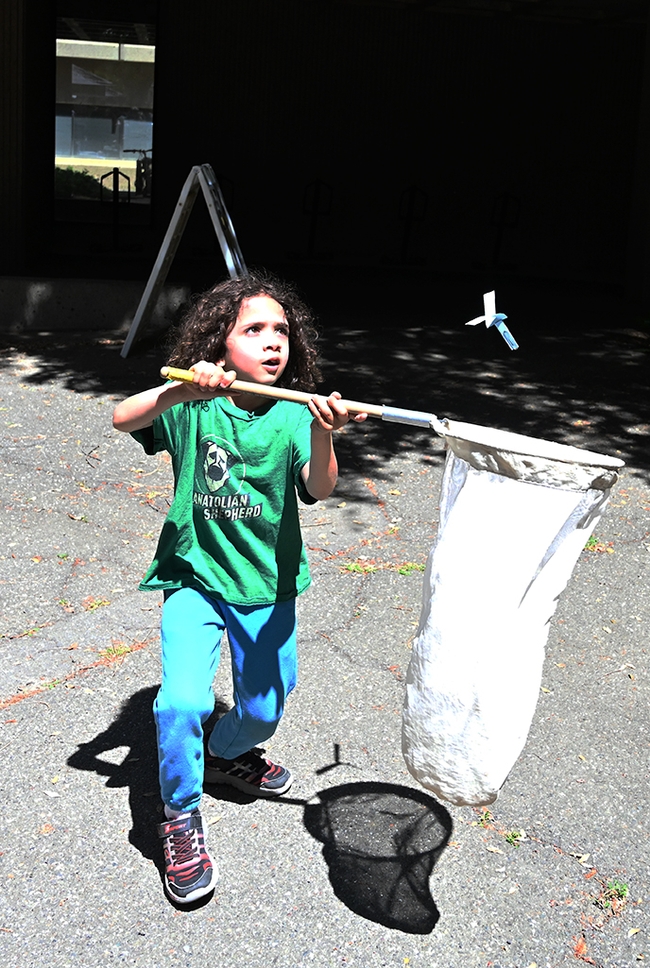
Visitors received free posters of the colorful butterfly, the state insect; learned how to use an insect net to catch a paper butterfly; and posed for images behind the dogface butterfly face banner.
At the California dogface butterfly table, entomologist Fran Keller, a professor at Folsom Lake College who doubles as a Bohart Museum scientist and a UC Davis doctoral alumna, discussed her children's book, The Story of the Dogface Butterfly, published in 2013.
Popular in kindergarten through sixth-grade classrooms, and in private and public collections throughout the country, the 35-page book tells the untold story of the California dogface butterfly (Zerene eurydice), and how a classroom successfully mounted a campaign to convince the California State Legislature to name it the state insect in 1972.
The book depicts the life cycle of the butterfly and also discusses the larval host plant, false indigo (Amorpha californica). The photos, primarily taken in Auburn on Placer Land Trust private land, are by Bohart associate Greg Kareofelas and Keller. Laine Bauer, then a UC Davis undergraduate student, created the illustrations. The book is available at the Bohart Museum, located in Room 1124 of the Academic Surge Building, 455 Crocker Lane.
The posters, also the work of Keller and Kareofelas, show a male and female dogface butterfly. The male is nicknamed "the flying pansy," and sports a doglike yellow silhouette on its wings. The female is mostly solid yellow except for a single black spot on its upper wings.
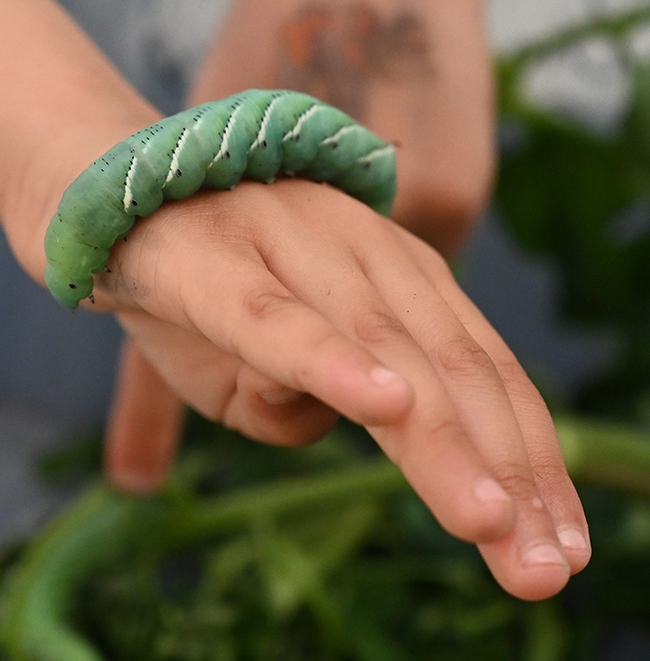
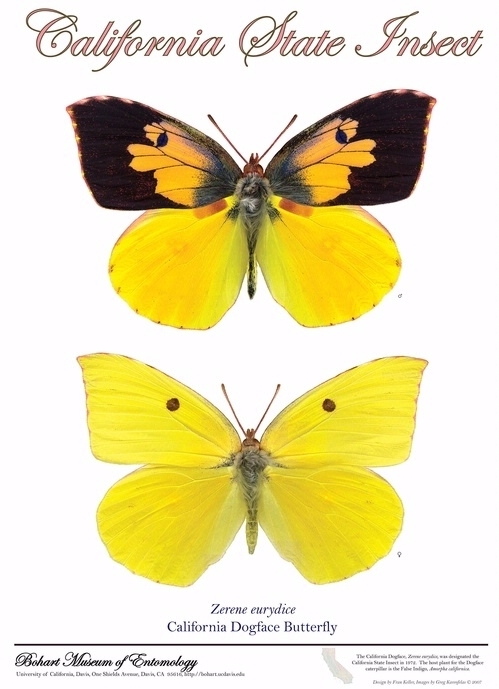
In the live petting zoo, visitors held thorny stick insects and tomato hornworm caterpillars. The caterpillars wlll become the five-spotted hawkmoth, Manduca quinquemaculata, family Sphingidae.
The Bohart Museum's Picnic Day display followed the theme, "Bonding with the Bohart," in reference to Professor Jason Bond, the newly announced director, as of Feb. 1. He succeeds UC Davis distinguished professor emerita Lynn Kimsey, who served 34 years as director. Bond is the Evert and Marion Schlinger Endowed Chair of the Department of Entomology and Nematology, and the associate dean, UC Davis College of Agricultural and Environmental Sciences. He also serves as president-elect of the American Arachnological Society.
The next Bohart Museum open house will take place Sunday, May 19 from 1 to 4 p.m. The theme: "Bees, Both Wild and Managed," featuring the research of scientists from the Department of Entomology and Nematology. The event is free and family friendly. Parking is also free.
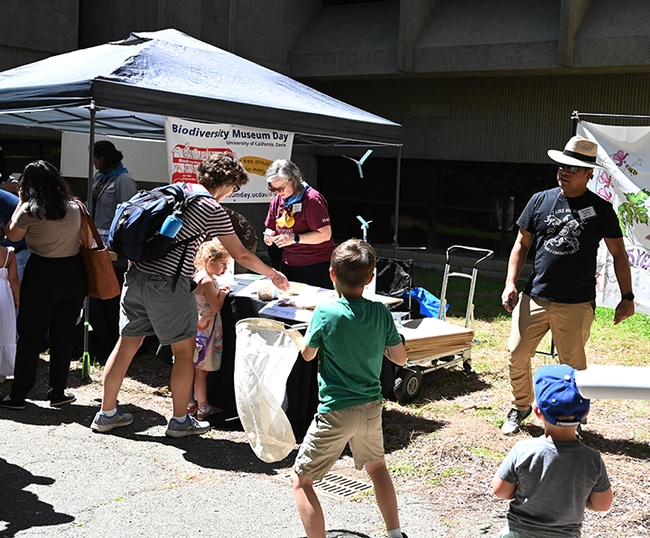
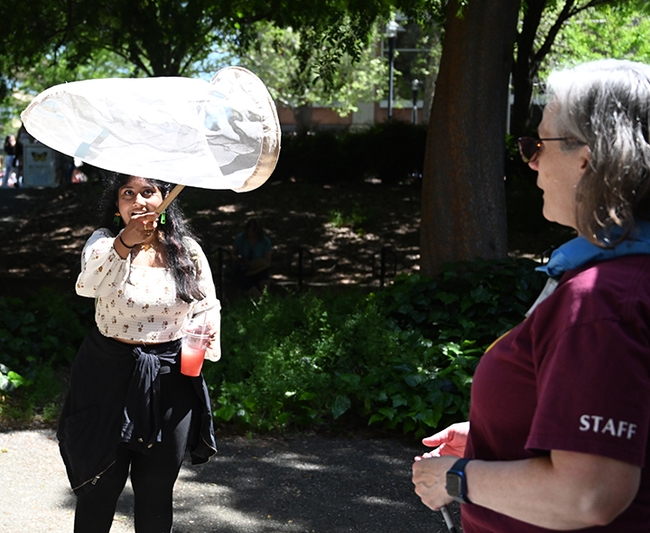
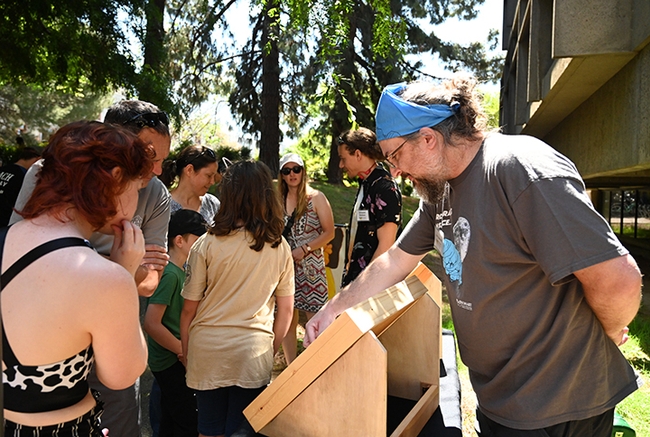
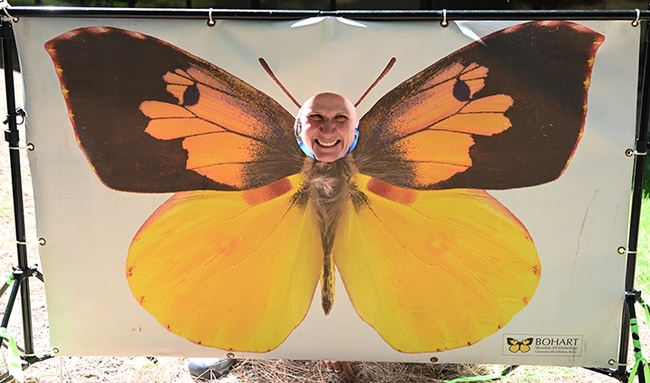
- Author: Kathy Keatley Garvey

In celebrating the California dogface butterfly, Zerene eurydice, visitors at the Bohart Museum of Entomology open house learned about the biology and history of the insect, engaged in arts and crafts, and enjoyed two specially decorated sheet cakes, one featuring the male dogface butterfly and the other, the female.
The occasion: the 50th anniversary of the year that the California State Legislature designated the California dogface butterfly as the state insect. Most attending the open house have never seen the butterfly in the wild.
The dogface butterfly, found only in California, thrives at its major breeding ground, the Shutamul Bear River Preserve in Auburn, a private preserve maintained by the Placer Land Trust (PLT). It's there because its host plant, false indigo, Amorpha californica, is there--amid the steep canyons, wildflowers poison oak and other vegetation.
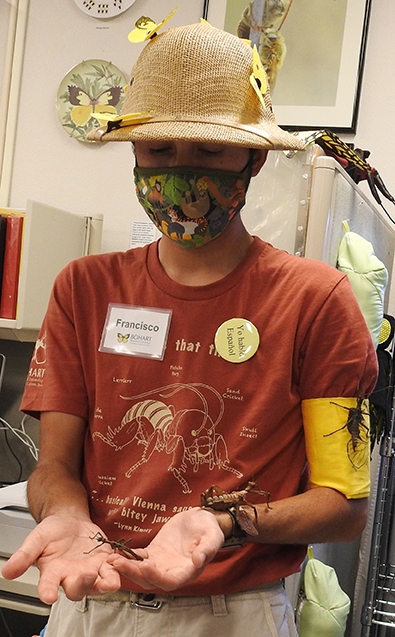
Kareofelas, who has reared multiple dogface butterflies from egg to caterpillar to chrysalis to adult, showed a PowerPoint of images he captured of the life cycle and discussed the history and biology of the butterfly. He serves as a volunteer docent for PLT.
Communications specialist Julia Boorinakis Harper Barbeau of Placer Land Trust narrated a video and staffed a table with fellow PLT'ers Carole Gan and CollinHobb. Among others participating was naturalist and PLT docent volunteer Deren Ross, credited with finding the first dogface butterfly at the Shutamul Bear River Preserve. (See PLT news story)
UC Davis students and Bohart volunteers Danielle Sion and Amberly Hackmann encouraged the guests to make yellow felt butterflies, ornaments for their shoes, hair, belt and wrists. Guests also crafted caterpillar puppets. A stick insect at the Bohart Museum petting zoo, took the opportunity to walk on one of the caterpillar puppets.
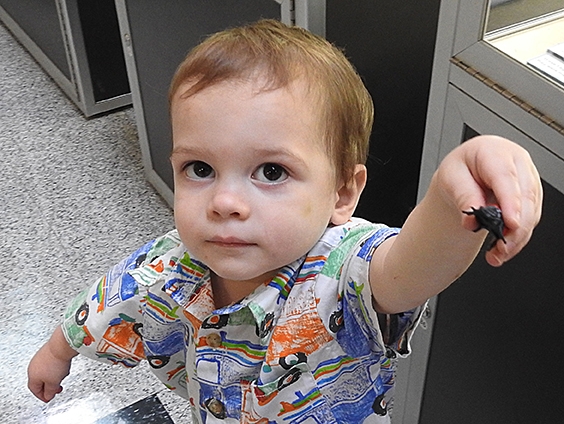
Entomologist Jeff Smith, curator of the Lepidoptera collection, showed specimens, including dogface butterfly, monarch, morpho and viceroy specimens, and answered questions.
Meanwhile, entomologist and Bohart lab assistant Brennen Dyer staffed the gift shop. A budding entomologist named Chip, 2, of Woodland, showed off his newly purchased bug habitat cage and some toy critters.
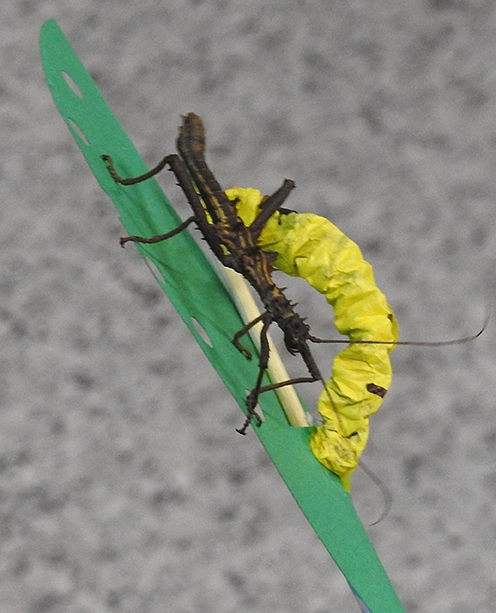
The Bohart Museum, directed by UC Davis distinguished professor Lynn Kimsey, houses a global collection of eight million insect specimens. It also maintains a live petting zoo and an insect-themed gift shop (including T-shirts, hoodies, books, jewelry, posters, collecting equipment).
The next Bohart Museum open house will be the annual Moth Night, held in observance of National Moth Week. The open house will be both indoor and outdoor from 8 p.m. to 11 p.m., Saturday, July 30. The event is free and family friendly, and visitors are encouraged to explore the world of moths in the Bohart's research collection and to see what lands on backlighting display: a hanging white sheet, illuminated by ultraviolet (UV) light and powered by a generator. The backlighting display will be a short, walking distance from the museum.
This summer the Bohart Museum is open to the public Monday through Thursday from 9 a.m. to noon and from 1 to 5 p.m., but groups must make reservations and all must follow the UC Davis visitor guidelines: https://campusready.ucdavis.edu/visitors?.
